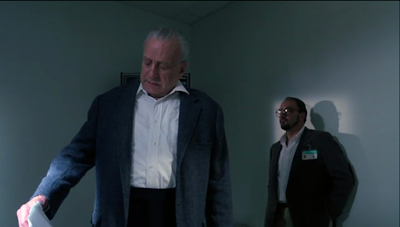 The Exorcist III (aka Legion) (William Peter Blatty, 1990) An odd little experiment in horror, more compelling than William Friedkin's chest-thumping original,* with more humor—Blatty had, previously in his career, written some quite funny scripts for Blake Edwards in the 1960's—and some genuinely unnerving moments that may not make one jump out of one's seat (well, one thing will), but will certainly creep one out.
The Exorcist III (aka Legion) (William Peter Blatty, 1990) An odd little experiment in horror, more compelling than William Friedkin's chest-thumping original,* with more humor—Blatty had, previously in his career, written some quite funny scripts for Blake Edwards in the 1960's—and some genuinely unnerving moments that may not make one jump out of one's seat (well, one thing will), but will certainly creep one out.It begins with a little bit of catch-up and two fine actors who did not appear as these characters in the original Exorcist—but probably should have. Lieutenant Kinderman (George C. Scott) is meeting up with old friend Father Dyer (Ed Flanders). It has been 15 years since the events of the original Exorcist, and the two men have had a steady friendship with shared lunches and grousing about their work-lives—Scott and Flanders are so good that they milk laughs out of lines that are as dry as a dessicated bone. When we see them, they're both trying to cheer each other up, remembering their mutual friend, Father Damian Karras (Jason Miller) on the anniversary of his death, sacrificing himself in the act of an exorcism.
It's an off-kilter, unnerving way to start a horror movie, a little bit like starting a corporate speech by laying off your employees with a joke. And that odd humor occurs often, with stray one-liners and the bizarre visual touch, sometimes lurched into the foreground, sometimes folded into the cracks of a frame. It walks arm and arm with Blatty's atmospherics of weighted...pauses in conversations, shifting shadows, slight zephyrs of wind, and the occasional breath of laughter. Odd and unnerving are the two words that best describe The Exorcist III.
Kinderman is investigating a bizarre series of murders that have ties to the exorcism of Regan McNeil, and that bear the un-publicized M.O. of "The Gemini Killer," who had been executed 15 years before. As if that wasn't bizarre enough, the murderer leaves behind a different set of finger-prints at each murder scene. There is more than one killer with secret knowledge, and the investigation soon zeroes in on Georgetown's Catholic hospital, where in the bowels of the psych ward sits a chained amnesiac, named "Patient X," found wandering aimlessly 15 years before. When Kinderman's investigation takes him to this room, he finds the form of his friend, Fr. Damian Karras.
What is Karras doing there, and why? Kinderman soon finds that he's not just talking to Karras, but also the form the "Gemini," who to serve his "patron" exacted revenge on Karras by taking over his body and, now, with consciousness regained, the "Gemini" prowls the hospital looking for new hosts and new victims.
It sounds absurd, utterly bonkers when relaying it in outline, but one cannot deny how effectively all this plays on the screen. What makes the film work is Blatty's assured direction, his devilish (if you will) humor and the total commitment of all the actors to the film and grounding it in some filmic reality. If you're going to believe in the spirit-world (as The Exorcist certainly does), you've got to wonder what happens when even a bound devil takes the gloves off and takes advantage of a truly evil spirit. Bonkers, yes, but not the way Blatty plays it.
The film was compromised somewhat by the studio's insistence that there be an actual exorcism (by Nicol Williamson's cameo priest), thereby muddling up the finale, but the film up to then is disquieting and in a far less bluntly hammering way than Friedkin's head-spinning original. Blatty's direction makes you not trust the film, and to be wary of what awaits on the other side of every edit he makes (and just when you think you have his pattern figured out, he will do something different).
He's not afraid to harness Scott's penchant for untethered behavior in his performances, but the kudo's for the best performance of the film belong to Brad Dourif. Quick as mercury, quirky as Hell, his performance as "Patient X" (a role shared by Miller and the voice of Colleen Dewhurst, the former Mrs. Scott), is a tour de force played mostly to the camera in long unbroken takes, with the odd touch of a tear that slides down the left side of his face, and the electronic manipulation of his voice to drop it into the lower depths. The movie starts to fall apart once Dourif departs (and when the studio-influence starts), but for most of its running time, it manages to rise above the other films in the series.






No comments:
Post a Comment